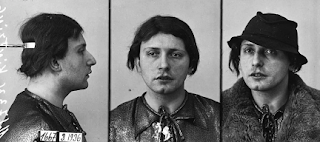Kitzing was born and raised with the name Fritz in the garrison town of Neuruppin, northwest of Berlin. Kitzing trained as a bookkeeper and moved to Berlin in the late 1920s. In late 1933 Kitzing was arrested on Augsburger Straße while in female clothing and charged with prostitution under §361/6 (which dealt with female but not male prostitution) which led to four weeks in jail and then six months in the Rummelsberg workhouse as “protective custody”. Kitzing managed to escape 16 March 1934 while en route to the dentist, and with family help made it to England. However an arrest in London for prostitution led to deportation back to Berlin, although not to re-imprisonment.
Fritz, realising the political situation, was now mainly wearing male clothes. However in June 1935 it was alleged that while walking in female dress near Kurfürstenstraße, he met a Sturmabteilung (SA) man, Herman Rank, out of uniform, and made a pass. Kitzing admitted being gay but denied solicitation. Simply being gay was not a crime up to that point but the Nazi government was about to change the rules. Kitzing was dismissed with a warning.
The police kept watch on Kitzing, but did not catch him in female dress. However, in July 1935 a neighbour complained to the police of a transvestite making trouble. This was taken to be Kitzing, but arrest was eluded until March the next year. A search of her apartment revealed her female clothing, which was confiscated and put in storage. After finally being arrested Kitzing was obliged to dress in the stored clothing and be photographed.
The police wrote to the Gestapo that “It would be a great service to the public—and even to these morally depraved people themselves—if we sent Kitzing to a concentration camp”. Despite this, Kitzing’s family, especially the brother Hans Joachim, continued to be supportive. Kitzing served five months in the Lichtenburg camp, and was then transferred to Sachsenhausen, before being released in April 1937.
In March 1938, a fellow inmate from Sachsenhausen recognised Kitzing although she was then dressed as female, and informed the police, who told the Gestapo who made an arrest. They discovered letters to friends in London describing conditions in Sachsenhausen. Kitzing was accused of distributing “atrocity propaganda”. He, as were many others, was compelled to enlist in the Wehrmacht, and was in occupied Belgium for most of WWII.
Afterwards he returned to West Berlin and worked in an antique shop. Kitzing lived until the 1990s. The brother Hans Joachim, a writer, was a war correspondent in Rostov. He never returned from the war.
- Andreas Sternweiler. “Er ging mit ihm alsbald ein sogenanntes ‘Festes Verhältnis’ ein: ganze normale Homosexuelle”in Joachim Müller & Andreas Sternweiler, eds. Homosexuelle Männer im KZ Sachsenhausen. Berlin: Rosa Winkel, 2000: 58-78.
- Clayton J Whisnant. Queer identities and politics in Germany : a history, 1880–1945. Harrington Park Press, 2016: 231
- Jennifer Evans & Elissa Mailänd. “Cross-dressing, Male Intimacy and the Violence of Transgression in Third Reich Photography”. German History, 39,1, June 2020: 2-10, 19, 22-4.
- W Jake Newsome. “Fritz Kitzing”. LGBTQ+ Stories from the Holocaust, Online.
- Jennifer V Evans. The queer art of history : queer kinship after fascism. Duke University Press, 2023: 36, 92-7.
- Joanna Ostrowska. “Non-heteronormative victims of the Nazi regime” 39-45 Chronicles of Terror. No date: 3. Online.
- Jennifer Evans summarises Kitzing’s story in Twitter/X.
"And yet, using Kitzing’s images as ‘proof ’ of homosexual or trans persecution carries the risk of freezing the historical subject in an identity that is not in line with other ways of seeing him. Similarly, viewing Kitzing solely as a male to female transperson, alienated from self and society, belies the fact that he may not have understood himself in these terms. Placing Kitzing within either of these two identity categories cuts him off from other, perhaps simultaneous, identities with which he may have moved through Nazi Berlin. As Jin Haritaworn warns, there is an epistemological side effect to reducing ‘queer’ to an identity category for emancipatory projects.‘Queering up’ for purposes of inclusion has the potential to homogenize dissonance anew. "
Kitzing never applied for a Transvestitenschein. She may have had a female name for herself, but it is not recorded.
Evans incorrectly claims that Hirschfeld had coined 'transsexual' and, despite her paragraph that I have just quoted, uses it re Kitzing. See my Did Hirschfeld coin the word and concept ‘transsexual’?


Wow. I am so grateful and excited to discover and bookmark your blog. Thank you so much for detailing the histories of our trancestors. Sincerely, a young trans nonbinary person.
ReplyDeleteI met Fritz Kitzing in 1976 when I was 16, when my parents and my aunt, who also owned an antique shop, visited him several times in his antique shop in the Mommsenstrasse and at his home next to Tempelhof airport, where he lived with his housekeeper Mrs. Behr.
ReplyDeleteHe was a very polite fellow with a "Berlin accent" who humorously described many stories about his life after the war, including how he had ripped off Russian soldiers on the black market in 1945/46.
With him as our private tour guide, we learned a lot about old Berlin away from the tourist routes.
In 1980, I visited him again with my mother, but he rarely went to his shop at that time.
His "trademark" still was looking at his competitors' shops in women's clothing in the Mommsenstrasse, Uhland-Strasse and Keithstrasse ("strasse"="street").
It's a shame that he died so early.
Fritz Kitzing died in year 1987, as some sources in the internet mentioned it.
ReplyDelete